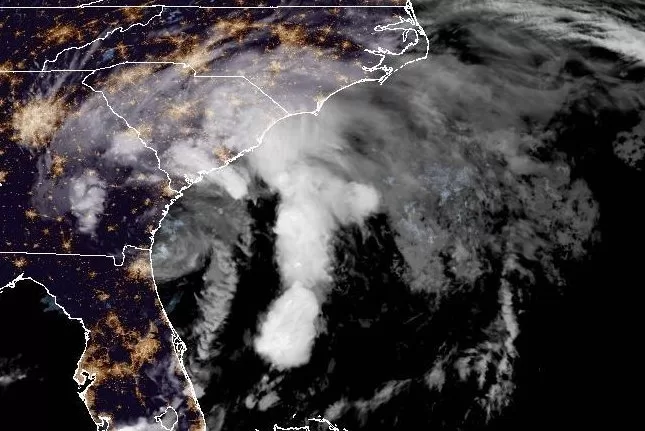A weakened Tropical Storm Debby moved over Georgia early Tuesday after making landfall Monday morning in Florida’s Big Bend region as a Category 1 storm. Photo courtesy NOAA
Aug. 6 (UPI) — A weakened Tropical Storm Debby was over southeastern Georgia early Tuesday as it inched its way toward the U.S. southeastern coast after making landfall in Florida on Monday.
Forecasters said the storm, which made landfall in Florida’s Big Bend region Monday morning, is expected to move across southeastern Georgia Tuesday and will reach North Carolina by Friday, likely as a depression.
The storm was located about 40 miles west of Brunswick, Ga., and 65 miles north of Jacksonville, Fla., with maximum sustained winds of 45 mph, the National Hurricane Center said in its 2 a.m. update.
Forecasters said it was moving northeast at 7 mph.
NHC is forecasting a turn toward the east on Tuesday, followed by a turn to the north at a low forward speed Wednesday. On the forecast track, Debby will move offshore of the South Carolina coast by late Tuesday and Wednesday, and approach the South Carolina coast on Thursday.
Debby is expected to produce potentially “historic” rainfall totals of 10 to 20 inches, with maximum amounts of 20 inches, threatening “catastrophic flooding” across portions of eastern Georgia, the coastal plain of South Carolina and southeast North Carolina through Wednesday, the forecaster said.
“This is a life-threatening situation,” NHC said. “Persons located within these areas should take all necessary actions to protect life and property from rising water and the potential for other dangerous conditions. Promptly follow evacuation and other instructions from local officials.”
A tropical storm warning was in place for Ponte Vedra Beach, Fla., to Little River Inlet, S.C.
A storm surge warning is in effect for the coasts of South Carolina and North Carolina from north of South Santee Rive to Cape Fear., N.C.
“The combination of storm surge and tide will cause normally dry areas near the coast to be flooded by rising waters moving inland from the shoreline,” NHC said.
Florida Gov. Ron DeSantis declared a state of emergency on Thursday night in 61 of 67 counties.
Previous storms were Tropical Storm Alberto, Hurricane Beryl and Tropical Storm Chris.

